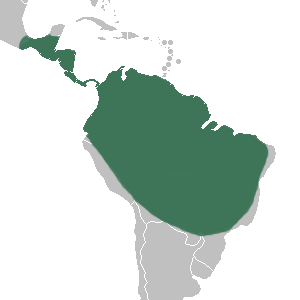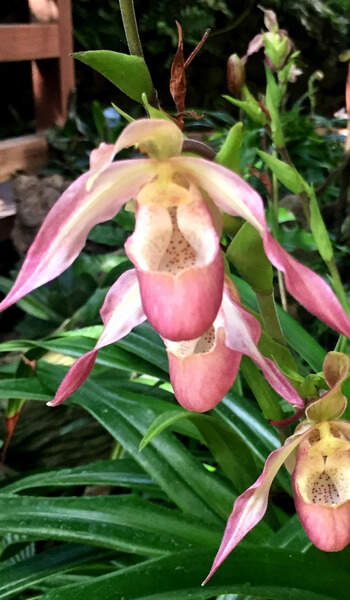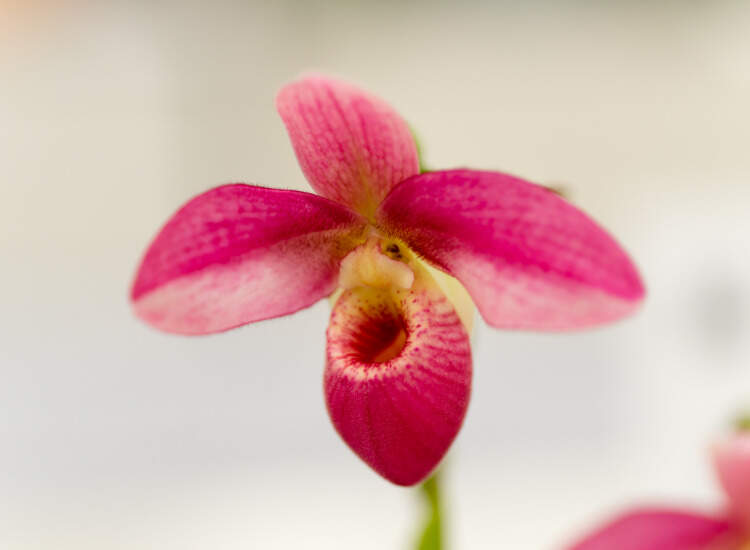Phragmipedium orchids are terrestrial plants, originating from Central and South America.
They are known for their large and colorful flowers, which are often compared to ballet shoes.
Despite sharing the nickname “slipper,” Phragmipedium orchids are different from Paphiopedilum orchids.
In this article, you will learn about the characteristics of species in this genus and also the necessary care to cultivate them.
Learn How to Achieve Super Blooms on Your Orchids
🛑 If you love orchids and you're tired of not being able to make them bloom...
Then, know that thousands of beginner growers are achieving beautiful flowers on their orchids by following this method.
Click the button below to have beautiful orchids with show-worthy flowers every year. ⤵
Characteristics
Phragmipedium orchids were established in 1896 in the publication Orchid Review 4 by Robert Allen Rolfe, a botanist specializing in orchid studies.
At that time, the species known as Phragmipedium caudatum was cataloged as Cypripedium caudatum.
This somewhat complicated name is derived from Greek and translates literally to “shoe division.”
- Phragma: division
- Pedilon: shoe
Today, this genus comprises 27 cataloged species (source), most of which are found in Mexico, but there are also species in Brazil, Guatemala, and several other countries.

They can be found in nature as:
- Humicolous, saxicolous
- Terrestrial (ground)
- Rarely as epiphytes.
They are sympodial orchids (grow vertically), their size can vary, from small species that grow only a few centimeters tall to larger species that can reach up to 90 cm (35.4 inches) in height.
Their leaves are green, long, and thin, in most species.
Flowers
Phragmipedium orchids have flowers of various shapes. Some are very similar to Paphiopedilum flowers, while others remind me a bit of phalaenopsis orchids.
The colors of these flowers can vary greatly:
- Yellow
- Green
- Brown
- Red
- Pink
But that’s not all; their flowers do not all open at once, they appear sequentially, meaning one appears, then another. So while some flowers are wilting, others are blooming.
How to Care for Phragmipedium Orchids
Phragmipedium orchids are beautiful plants and easy to care for. With a little attention, you can keep them healthy, beautiful, and ready to bloom in your cultivation area.
Below, you will learn the 7 necessary care steps for Phragmipedium orchids.
1st Temperature
Phragmipedium species generally adapt well to climates where the daytime temperature varies from 70 to 80°F (21 to 27°C) and nighttime temperature between 55 and 65°F (13 to 18°C).
This nighttime temperature drop is essential to stimulate flowering.
If you place your orchid near windows, remember that the temperature near the windows is not the same as inside the house. So be mindful of this aspect.
2nd Humidity
Humidity is one of the great advantages of this orchid; it is very resistant to high humidity. Therefore, beginner growers won’t have to worry too much about this factor.
It is recommended that humidity remains between 50 and 70%. If you don’t know how to measure humidity, you can buy a humidity meter or check a weather forecasting website.
3rd Watering
As they prefer slightly higher humidity, do not let your orchid’s growing medium dry completely. Therefore, wait until it is almost dry, and then water your Phragmipedium orchid generously.
To check if the growing medium is dry, you can:
- Insert your finger into the top layer of the growing medium, about 1-1.2 inches deep. If it feels moist, it probably isn’t time to water.
- Use a wooden stick: place the stick on the growing medium’s surface, near the orchid’s roots. Insert it about 1-1.2 inches deep. Do not force it too much to avoid damaging the roots. Remove the stick and check if it is moist.
Be very careful with excess water, as it can cause your orchid’s roots to rot. Also, be careful not to let water accumulate at the bottom of your pot.
4th Fertilizer
Regarding fertilizer, Phragmipedium orchids like plenty of nitrogen.
So a good idea is to use NPK 30-10-10 every 15 days during the summer because that’s when your orchid will be in its growth period.
Now when it exits this period, fertilize on average once a month, with a more balanced fertilizer such as NPK 20-20-20.
Never fertilize your orchid if it is dry because this can burn its roots and cause permanent damage.
And the fertilizer should be liquid and applied to the roots because that’s how orchids absorb nutrients best.
Do You Want to Learn How To Keep Your Orchids Healthy And Ready to Bloom Every Year?
So, I prepared a complete guide, step by step and illustrated, that will show you:
• The secrets to getting beautiful flowers every year
• How to fight and identify pests and diseases on your orchids
• THE MAGIC SUBSTANCE for orchids and how to use it
• And much, much more.
The great news is that the manual is now available at a super discount!!
But beware, it's only for the first buyers.
Click on MORE INFORMATION below and discover the secrets to show-worthy flowers. 👇
5th Lighting
In this factor, there is a small problem for you cultivating a Phragmipedium because some species need more light than others.
So, to avoid this problem, it’s ideal that you learn to monitor your orchids’ leaves.
Basically, your Phragmipedium’s leaves will help you understand if your orchid needs more or less light; see:
- If the leaves are very dark green: it needs more sun
- If the leaves are yellow or reddish: it needs less sun
Remember that it’s good to prevent your orchid from receiving direct sunlight, especially during the hottest parts of the day.
6th Planting Location
The first step in deciding where to plant your Phragmipedium is to find out if it’s an epiphytic or terrestrial orchid.
To do this, you can ask where your orchid was purchased. If that’s not possible, the safest option is to plant it in a pot.
- Epiphytic orchids cannot be planted in the ground but can be hung
- Terrestrial orchids cannot be hung but can be planted in the ground.
After choosing where you will plant your Phragmipedium orchid, watch the videos below to learn how to plant it:
It’s important to remember that repotting is recommended every 2 or 3 years.
In this process, you should remove the orchid from the pot, change the growing medium for a new one, and replant the orchid.
7th Substrates
When choosing growing media for your orchid, we recommend that you opt for ready-made formulations available in orchid nurseries or gardening stores.
Another option is to assemble your own growing medium, where you can use materials such as topsoil, pine bark, perlite, etc. To learn how to choose the best **growing media** for your orchid, see this article.
Conclusion – Phragmipedium Orchids
Those were the tips on how to cultivate Phragmipedium orchids. If you want to learn more about orchid cultivation, you can access the articles below:
If you liked this article, help us by sharing this content on your social networks.
This way, you’ll help the website and also contribute to the dissemination of the Phragmipedium species to more people, as it is not very well known.
Click the buttons below and share this article.




















